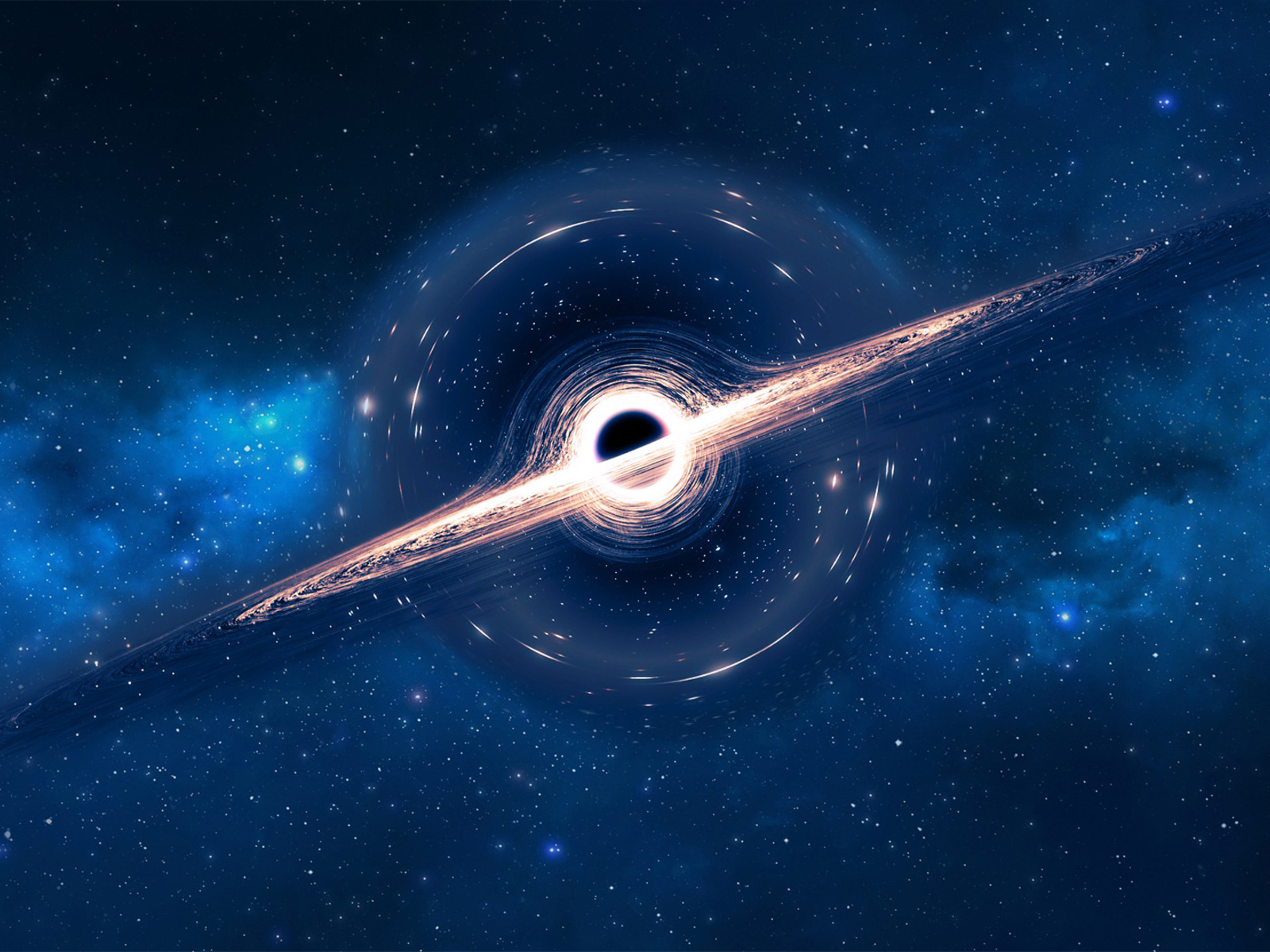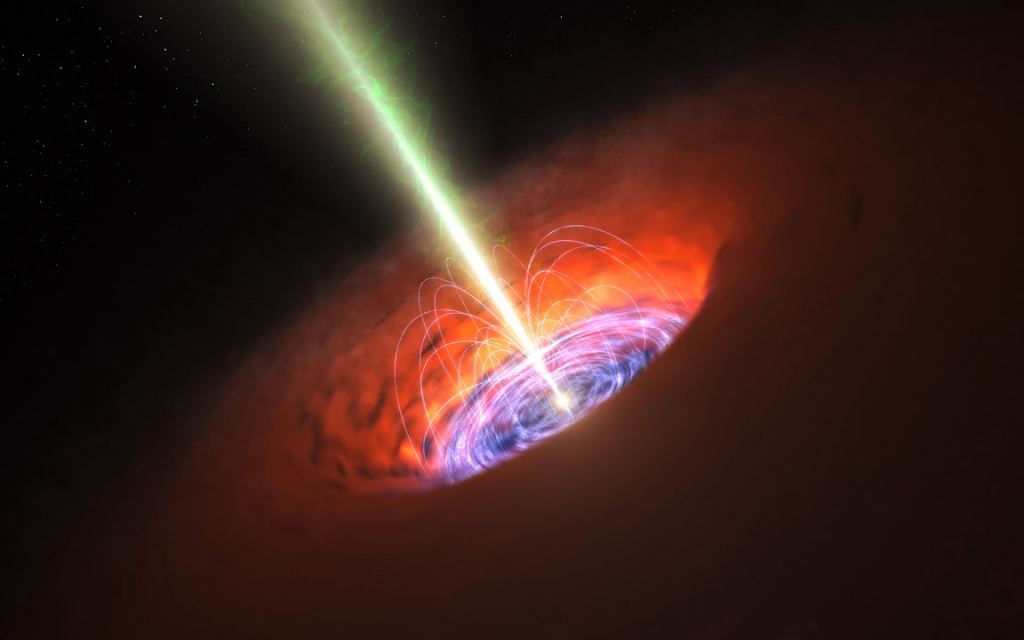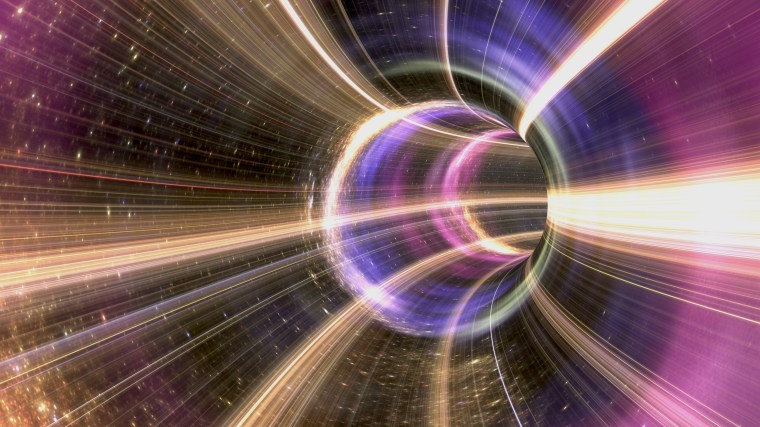The black hole is a region of space that can be thought to be extremely dense or packed with matter. A black hole is so dense that not even light can escape its gravitational pull.
Now that may sound strange! To understand the black hole, we have to first go back to the basics, understand why it’s called a black hole and you must first change your perspective of the universe else you are going to totally get confused and lost after reading through this article.
Space as a Rubber Sheet

Based on our earlier view of space, it was thought to be just a vacuum that is so large that its diameter cannot be calculated, rather, it can only be assumed, it was thought to be a vacuum that contains a whole lot of star clusters and galaxies, Nebulas, Comets, Asteroids, Meteors, Planets, dark matter, dark energy, and all that can ever be imagined. But there’s more to space than that. In the early 1970’s when space exploration was still in its infancy, a renowned and learned professor would simply tell you that space is but a vacuum which contains planets, comets, asteroids, and a lot of other objects and particles and that it has a diameter of 105,700.0834 light years (the diameter of the milky way galaxy). Now that’s a lot recent still, going down history, you will realize that man’s understanding of space grows by the day.
Sticking to a your initial understanding of the universe, you will realize that your view of the universe would be no better than that of the professor (used in the article). Sticking to the present understanding of the universe would do you no good either; this is because space is big, extremely big and is way older than man can comprehend.
“Space is big. Really big. You just won’t believe how vastly, hugely, mind-bogglingly big it is. I mean, you may think it’s a long way down the road to the chemist, but that’s just peanuts to space.
Douglas Adams
From Albert Einstein’s theory of relativity, he explained that space can be seen as a rubber sheet. He also stated that time is the fourth dimension That would be explained later.
Albert Einstein usually related to the space as a rubber sheet stretched over a baking dish. He did this to explain in more details the theory of relativity.
Why Exactly Do We Have To Imagine Space As A Rubber Sheet?
We see space as a rubber sheet so that we can understand in more details what the black hole is all about without getting confused. We do that so that we can understand in more details how space and time are related as stated in Einstein’s theory of relativity.
Think of space as a rubber sheet spread on a very large surface. When a heavy body is placed on a rubber sheet, it causes a dip (stretch the rubber sheet). When a ball is rolled on it, it tends to orbit the heavy object even though it was thrown along a straight line. When a heavier object is placed, it courses a much deeper pull which is known as “gravitational well”. The heavier the object, the deeper the gravitational well.
Once you are able to understand this, understanding the black hole won’t be a problem.
John Wheeler once said that “Spacetime tells matter how to move; matter tells spacetime how to curve.” Once one accepts the curvature of space, it’s rather easy to see that smaller objects will tend to move along the straightest possible line that they can in that curved space. In curved space, the rules of Euclidean geometry are no longer valid. For example, it’s possible for parallel lines to meet. Think of the lines of longitude on a curved spherical globe: They are parallel at the equator but meets at the poles.
Also, the sum of angles is not equal to 180O: think of longitude that meet at the poles (north or south), and the segment of the equator joining them. This triangle has two right angles at the equator, and a non-zero angle at the apex (polar region). Hence, the sum is greater than 180. Once space itself is curved, everything moving around it is affected. Thus not only particles, but light too must feel the effect of gravity when it encounters a very strong gravitational pull. This explains the effect of the black hole on light particles (photons).
Since you now have a background picture of the modern universe and relativity, what then is the black hole?

The black hole is a region in space that is so densely packed with matter that it courses a tear in the fabric of space time. The black hole is a region of space where the known laws of physics breaks down. It’s an event horizon, that is, the point of no return.
The gravitational pull of a black hole is so great that not even light can escape its gravitational pull.
The black hole is black because no light can go across it, and no light gets out of it. It cannot be seen because it pulls all the light into its middle. Scientists know its there by observing its effect on other stars and gases around it.
Based on our knowledge of physics, there would be no gravitational pull around a black hole.
If we were to approach the black hole with the concept of Newton’s law of universal gravitation, we are going to get confused as to where the force of gravity originated from because based on the Law of Universal Gravitation:

F = GN .M1 .M2 / r2
F in this sense refers to the force of gravity.
GN is used to represent the Universal Gravitational Constant which has a constant value of 6.67 x 10-11.
M1 is the mass of the first object
M2 is the mass of the second object
r is used to represents the distance between the two objects.
If a calculation was to be made based on this equation, it would result to zero (meaning that there would be no force of gravity between the two bodies)
F = GN .M1 . M2 / r2
F = The force of gravity
GN = 6.67 x 10-11
M1 = Mass of the black hole
M2 = Mass of light (Photons are massless – they have no mass).
r2 = the distance between their radius squared.
Going by the values given above and equation of Universal Gravitation, the value of the force of gravity would be zero. The product of the Universal Gravitational Constant, the mass of light and that of black hole would return zero.
F = 6.67 x 10-11 x M1 x 0/r2
F=0/r2
Recall that:
0/x =0
Therefore, it will return zero, that is, there is no force of gravity between the two. This exactly was the problem with Newton’s law of universal gravitation and it was the reason for the invention of Einstein’s equation for general relativity, the law of universal gravitation was actually really not as universal as the name stated, it was more or less centered on classical physics and had nothing to do with a black hole. Well, maybe that was because their view of the universe at that time was shallow; they still saw space as a mere vacuum and not as the elastic sheet like we do today.
HOW DO BLACK HOLES FORM?

Scientists say that the smallest black holes where formed at the same time when the universe began. They also believe that the super massive black holes where formed at the time that the galaxy in which they exist was formed.
A Stellar Black Hole is formed when a star which has reached its full age collapses into its core. During this process, it form a supernova (supernova is a star that explodes and some of its matter is blow into space.)
At birth, a star is formed as a white dwarf, in its middle age, it then becomes a yellow star (just as our star – the sun). When a star reaches its full age, it then becomes a red giant.
During the life cycle of a star, when it becomes a red giant, it then gradually runs out of fuel. At this point of its life, it explodes, forming supernovae. After its death, it will then collapse into a neuron star. When the neuron star collapses due to its extremely mass, or when two white dwarfs collide, they results into a black hole. A black hole is an intense gravitational field left when a red giant star collapses.
The center of the black hole which is infinite dense and has no volume is what is termed as a Singularity and the surface of the black hole is
The radius of the event horizon can be calculated using:
RH = 2GM/C4
Where:
RH = The radius of the horizon.
G = The universal gravitational constant
M = Mass of the black hole
C = Speed of light
WHAT IS THE SIZE OF BLACK HOLES?

The truth is that black holes have no specific size, they range from big to small to extremely large/small black holes. The smallest black hole can be as small as an atom. These black holes may be as small as the atom but have the mass of a mountain.
Stellar black holes are usually twenty times as massive as the sun. There are many of this stellar black holes in our galaxy. Black holes may be small in size but their mass is way beyond their physical size.
Another type of black holes – the Super Massive Black Holes have the mass of about one thousand suns. Research shows that in every large galaxy, there is a super massive black hole in its middle.
Does This Then Mean That There Is A Black Hole In The Milky Way Galaxy?
This may surprise a lot of you, but there is a black hole right in the middle of the Milky Way galaxy. It is called Sagittarius A. Sagittarius A is a super massive black hole that has a diameter of 88 million km and a mass equal to about 4 million suns.
Even though there is a black hole in the middle of our galaxy, that does not mean that it is going to destroy the earth because the black hole is no way close to our solar system and would not in anyway get close to our solar system anytime soon.
WORM HOLES

Anything that can be torn can in turn be sewn isn’t it? It’s Mathematically/theoretically possible to take two black holes and geometrically sew them together along their “tears”. This gives a rise to wormhole solution to Einstein’s equation, in which two otherwise separate universes or two parts of the same universe is linked together by a throat. The problem with the wormhole theory is that it very unstable. The wormhole collapses almost immediately after it is formed. This is a far shorter time than is needed to get through to the other side.
The Theory for General Relativity
Space is a vacuum which is wrapped around time. Space and time are interwoven.
Looking at Einstein’s equation for general relativity, you will understand that all four dimensions are at work in space. Speaking about the four dimensions, I assume that you already have a basic idea or understand what I mean by the fourth dimension. Aside the three dimensions which we are already familiar with, we also have a fourth dimension, which is “time”.
In the equation for general relativity:
Ruv - 1/Rguv = 8πGN/C4 × Tu
GN = Universal gravitational constant which has a constant value of 6.67 × 10-11
The equation contains Greek letters and is labels which can each take the values 0,1,2,3.
The equation , conceals a whole collection of equations corresponding to the possible combinations.
This equation can also be represented as:
- R00 – 1/Rg00 = 8πGN/C4 × T00
- R01 – 1/Rg01 = 8πGN/C4 × T01
- R11 – 1/Rg11 = 8πGN/C4 × T11
and so on.
The value 0 corresponds to time, 1,2 and 3 corresponds to the other three dimensions of space.
The equation: R01 – 1/Rg01 = 8πGN/C4 × T01 therefore relates to time and the 1 direction of space. The term on the right hand side of the equation (8πGN/C4 × T01) describes the momentum (speed and mass) of the matter moving in the 1 direction of space to mix and wave into each other – that effect is described by the left hand side of the equation (Ruv – 1/Rguv ).
If the equation has only 1s, 2s, or 3s, e.g R11 – 1/Rg11 = 8πGN/C4 × T11, then it relates to space. The right and side of the equation now measure the pressure that matter causes in the corresponding direction of space. The left hand side of the equation tells you that matter caused space to curve in the direction of the stretch.
If both takes the value 0, then the equation only relates to time. The term now stands for energy, which causes time to speed up or slow down. The left hand side of the equation describes that change in the flow of time.
RELATIONSHIP BETWEEN TIME AND THE BLACK HOLE

As we earlier stated, a black hole is a region of space where all the known laws of physics break down. If you adopt the mindset that space is like a rubber sheet which curves in the shape of the mass placed on it, then we will understand the black hole better.
Time and space are warped together. When a large object is placed on a rubber sheet, it tends to course a deep in the rubber, also when a heavy mass is formed in space, it courses a deep in space and also tends to slow the flow of time because time is tangled/warped with space, the heavier the body, the slower the flow of time around it and vice-versa.
Time is the fourth dimension of spacetime, while the other dimensions locate the position of an object along the “x-”, “y-”, and “z-axis”, time finds the exact instance that it occurred. Unlike other dimesions of space time, time can only be thought to travel forwards.
Time is slower around heavy objects.
The black hole is a very massive object, just like the law of physics predict, it slows down time due to its excessive mass. Around the event horizon, time begins, to slow down and once an object crosses in, time appears to be frozen, time stops.
If a person for instance falls into a black hole, from an observer afar, he seems to slow down as he approaches the event horizon until eventually, time stops and he appears to be frozen.
Stephen Hawking predicted that one can travel into time using the black hole; he predicted that if one is able to orbit from a safe distance around a black hole, he could travel into time.
POSSIBILITY OF TIME TRAVELING

No doubt, time dilates around a black hole and is believed to freeze once you go beyond the event horizon (the point of no return), yet it does not guarantee the possibility of time travelling.
First, the closest black hole to us “Sagittarius A” is about 26, 000 light years away from Earth. What this means that, even if we were to build a space shuttle that travels at the speed of light, it would still take us 26, 000 years to get there, now that is enough time wasted already. It would just be safe then to say that it is never going to be possible, except teleportation becomes possible.
Astrophysicists believe that time is destroyed in the singularity while others say that time moves backward in a black hole, whatever the answer is, it is still a mystery as no one has ever gone any where close to a black hole.
DEATH OF A BLACK HOLE
Just as every other thing in space, a black hole also has a finite life time.
According to Stephen Hawking, as the black hole radiates energy, it shrinks gradually until it gradually evaporates. However, the timescale for a black hole to completely evaporate is extremely long. It would take trillions upon trillions upon trillion times the age of the universe for a black hole with a mass equal to that of the sun to completely evaporate. This is enough time for it to completely destroy an entire galaxy.
When next you here about a black hole, you should know exactly what it is, how it forms, the various types there are, its relation with time and its life time.
Below are some other links that can help you in understanding some key things about a black hole better.
More Links:
- How to calculate the mass of a black hole
- How black holes are detected
- List of black holes
- Einstein’s theory for general relativity
- Black hole theory and Hawking Radiation
- Possibility of time travelling.

Don’t forget to subscribe to our blog posts. Simply fill the form below, click the submit button and validate the action from your email.
You can also check out the related posts below for anyone that might interest you.
Do have a nice day


Concept is explained in a clear manner and I could relate various assumptions seen in the movie ” Interstellar”.
LikeLiked by 1 person